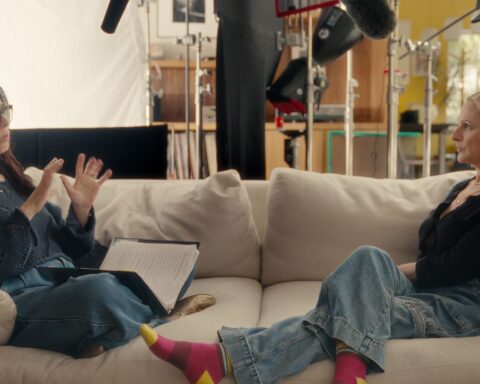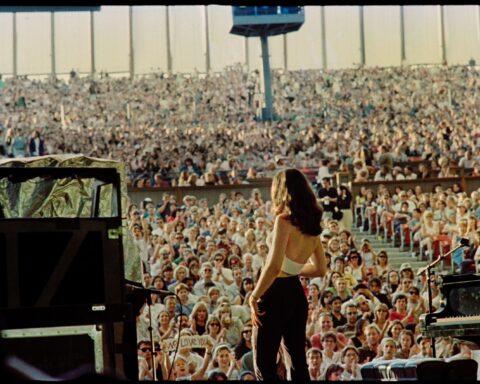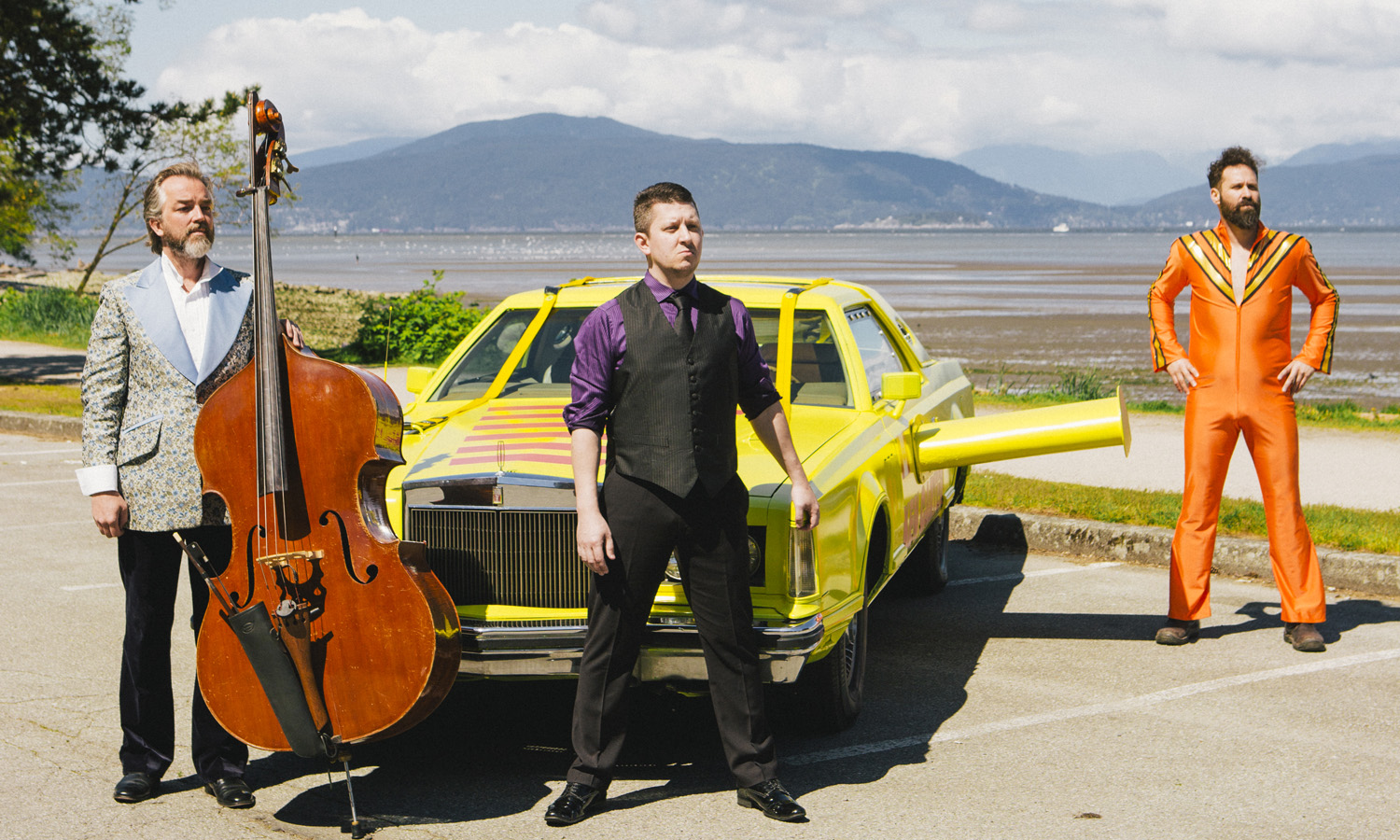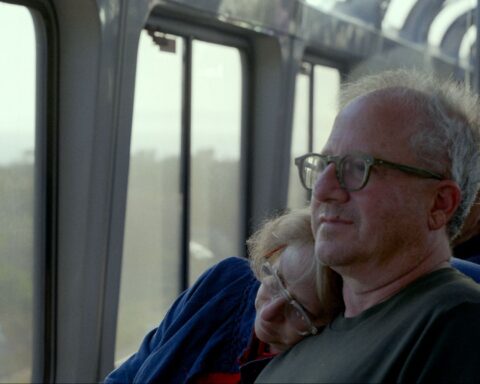The title of Hugh Gibson’s new documentary The Stairs refers to a stairwell that once served as a makeshift living space for Martin Thompson, a habitual drug user who’s diligently pulled himself back from the brink of oblivion. “Sit down in my living room,” he says with the same excitable cheerfulness that marks most of his pronouncements. Later in the film, Martin—Marty to his friends—will share a self-penned song about his one-time home. The gist of the performance is that he has literally and figuratively moved away from the stairs, but there’s a defiance in Marty’s voice that’s much closer to pride than it is to shame. This is a man with no illusions about the realities and contingencies of his life or those of the people around him. (Read the POV review of The Stairs here.)
“The stairs were always important,” says Gibson. The director (who, in the interest of full disclosure, is one of my oldest friends dating back to junior high school) says that the scene with Marty on the stairs was one of the first things he shot, and that from then on, he was keenly aware of the location’s metaphorical possibilities. “The thing about the stairs,” he says, “is that you never know if you’re up or down, or how far you have to go. And throughout the film, we see that all of the people change places on the staircase.”
The Stairs began as a series of educational videos commissioned by a Toronto Public Health harm reduction programme located in Regent Park, an area that has undergone massive redevelopment over the past six years. The group’s mandate includes supplying users with safe injection tools and sites, as well as supplying counselling and forms of mobile outreach, but despite its sterling reputation within the community, the programme was under fire in 2011. “It was a very different political climate,” says Gibson. “Rob Ford had just come into office, and he was opposed to these sorts of programmes. The health centre there was sort of under attack, and they felt like they needed to show the city why they were valuable. They wanted to show people what drug users are actually like, and what people who work in the sex trade are actually like. And so what started as a corporate job turned into something much more personal.”
Gibson spent a huge amount of time with the people who ran the programme and the users who came by every day for supplies and conversation. He saw that there was significant overlap between the two cohorts. Part of the impetus for turning The Stairs into a feature was to more thoroughly document that symbiotic dynamic. He also senses that many of the people he met were craving an outlet to tell their stories. “Over time, as I got to know the people, they came to trust me. I think the fact that I was non-judgmental…they respected that.” At the same time, figuring out how to select and work with subjects was a challenge, as was deciding exactly what sorts of stories were appropriate to tell.
“The first meeting we had as a peer group, I was explaining what I wanted to do and what the movie might be, and asking who would want to participate,” he says. “Someone asked me ‘how do you know if there’s going to be a happy ending?’ And someone else immediately answered ‘that depends on us, doesn’t it?’ I’ll never forget that, because the person who said that was a woman named Lisa, who was supposed to be one of the main characters. She passed away before we started shooting.”
The three leads in The Stairs are people who are in some ways still dealing with the traumas and transgressions of the past. In addition to Marty, whose current outlook is relatively bright (he shows off his one-room apartment and pet cat with a hard-won sense of accomplishment), the principals are Greg Bell and Roxanne Smith, both of whom are working to help other drug users while also addressing their own ongoing dependencies. Greg, whose taciturn demeanour hints at a serious temper, is recovering from a violent run-in with police officers that has resulted in a legal situation. Roxanne, who has worked in the sex trade since her teens, tries to reconcile the dangerous aspects of her lifestyle with her responsibilities as a mother. What Gibson gets onscreen is the fragile, provisional nature of treatment programmes that are designed primarily to mitigate suffering and improve health by degrees. “The typical narrative is that you’re a drug user, you’re addicted, you go to rehab, and you’re cured,” says the director. “Reality is quite different. It doesn’t end there. In a way, it’s just where the story begins.”
Many of the stories that are shared in The Stairs are harrowing, never more so than when Roxanne relates a nightmarish tale of abduction and captivity that may test even the most jaded viewer’s responses. There is a hushed, attentive quality to the filmmaking, (the fluid, intuitive camerawork is by the director and Cam Woykin) and the verité style, with its lack of narration or exposition, hearkens back to great non-fiction practitioners like Allan King. Gibson also cites Joshua Oppenheimer’s The Act of Killing (2013) and the works of Pedro Costa as inspirations, although he reserves his highest praise for a fellow Canadian: Alan Zweig, who is listed in the credits as an executive producer. “Alan’s film A Hard Name (2009) is the closest thing I’ve seen to a movie that has that sort of intimacy with its characters in a similar milieu,” he says. “Alan was involved from the beginning and he was there whenever I asked him to be. He also made three features in the time it took me to make this one.”
The prolonged shooting schedule for The Stairs could have resulted in a film of fragments, but the construction here is careful, and never more so than in the superbly realised final shot. Gibson says that he was guided throughout by the idea that his film could work in harmony with the sort of treatment he was documenting. “I thought that harm reduction was in the fabric of the movie, and its tenets are integral to how I made it. Being non-judgmental, having patience and acceptance. Or knowing that you can be challenged by a person’s behavior and still value them as somebody with feelings, who is worthy of dignity and respect.”
As a study of three people trying to break cycles of behaviour, The Stairs is compelling, but it’s also a work of local portraiture: long-time Torontonians will vividly recognise the east-end milieu known as Regent Park. And of course, to borrow a line from Luis Buñuel, the more specific a film is, the more likely it is that it can feel universal. “It’s about a specific neighbourhood in a specific city, but in my opinion, it really could be anywhere,” says Gibson. “Last summer in New York, I showed it as a work in progress for the Harm Reduction Coalition. There were maybe 20 people there with the same life experiences as Marty and Roxanne, and they all said they could relate to it, or that it actually was their lives.
Another new Toronto-based documentary takes a different tack in exploring the links between individual lives and the neighbourhood around them. “A community is like a stage,” says Charles Officer, whose Unarmed Verses focuses on Villaways, a housing complex on the outskirts of the city. The concept of performance surely applies to Officer’s film, which follows a group of children enrolled in an arts program at Villaways’ recreational centre designed to help them channel their fears and frustrations through music. Brought to a downtown studio to record their work, the kids unleash a series of original spoken word compositions. But as with The Stairs, Officer’s film is nuanced, with subtexts and a bit of a political agenda. Besides evoking the rap and hip-hop inflected songs that give the film its spine, the phrase “unarmed verses” smartly suggests the combination of adversarial anger and desperate helplessness that can build up in underserved areas.
“I would characterise [Villaways] as a marginalised community with a lot of passion and talent,” says Officer. “Race plays a part in the economic imbalance, the structure of society. It’s filled with people of colour, people from the islands, or from parts of Africa… the people [there] are brown people. That is the pocket. People are striving, trying to make things happen… but if there is not a shooting, if it’s not sensationalised, we don’t hear about their community or anything happening there.”
Unarmed Verses was shot in 2015, when the residents of Villaways were informed that the complex was slated for demolition and redevelopment one year later—a massive upheaval that would result in relocations to other parts of the city. Officer, who lives in Regent Park, says that he immediately recognised how the language of civic improvement can be used to finesse—or misrepresent—manoeuvres that are approved over the heads (and against the wishes) of the people they are purportedly designed to help. (Many people in the old Regent Park were displaced as the redevelopment of that neighbourhood took place.) “People use words like ‘revitalisation’ and ‘gentrification,’ all the time,” he says. “But I’m interested in the deeper effects of what’s happening to these spaces.”
With this in mind, Unarmed Verses unfolds as a kind of suspense narrative: the real backbeat behind the songs being written is the ticking clock of a wide-scale communal relocation. Officer, who developed the project at the NFB Ontario Studio with producer Lea Marin, spent two years at Villaways before he began filming. But once the announcement was made about the demolition, there was a new urgency to the project. “Art Starts [which uses the arts as a vehicle to encourage social change in Toronto’s underserved neighbourhoods] had been in [Villaways] for about eight years. They invited me in to film, and to collaborate. I asked if they would consider a music programme of some sort, since they hadn’t done that. They devised a plan, and hired music instructors, and I got a friend to donate time in his recording studio.”
Officer is best known for his 2008 feature drama Nurse.Fighter.Boy, and has recently directed episodes of several popular television shows, including the cop series Rookie Blue. His first non-fiction film, Mighty Jerome (2010), won an Emmy, but the filmmaker still says that working with nonactors is a significant adjustment. “You’re not coming in with a script. It’s more challenging. You have to learn to be very patient. With drama, you really work [to create] a moment with an actor. Here, it’s a different kind of trust. Somebody has to be OK with the camera being right next to their face. An actor expects that and hungers for it. A 12-year-old girl, it’s different—it’s big for her to give you that sort of trust.”
The undeniable star of Unarmed Verses is Francine Valentine, a reserved, cerebral 12-year-old girl introduced in the film’s opening shots poring over a homework assignment about Edgar Allan Poe’s chilling short story “The Black Cat.” Her thoughts about the torment of Poe’s nameless, anguished narrator indicates a skill for analysis that also hints at literary ambition: one way to look at her arc over the course of the film is that Francine goes from close reader to passionate writer. “That was one of the moments where I knew I was sticking with her,” says Officer. “Like, ‘this is the sort of writing she’s investigating on her own? Edgar Allan Poe?’ I was not reading Edgar Allen Poe at age 12. She chose that story because the words on the page intrigued her. I was blown away by that.”
The question of whether or not soft-spoken Francine will find her voice when it’s her turn at the mic hangs over Unarmed Verses, which features a number of powerful, momentary star turns from the other members of its ensemble. The poems range from existential reflections—“why do I exist?” begins one piece, overlaid by Officer and editor Andres Landeau on a God’s-eye view of Villaways blanketed in snow—to raw, wrenching pleas for love and intimacy. “There was very little pushing from me,” says Officer of his work with Villaways’ adolescents. “They got there on their own. I wanted them to be honest, and to speak what was in their hearts. They’re not trying to imitate anything, either. One girl came and she had 30 pages of verses on the very first day.”
At times, Unarmed Verses feels blatantly inspirational. A scene where the Villaways kids are taken to the Art Gallery of Ontario and introduced to the work of Jean-Michel Basquiat, described by the guide as a big enough star that he once dated Madonna, suggests both the aspirational pull of great art and the ways that it can be a vehicle for escape. But the film’s overall tone is melancholy, because its very existence testifies to a larger absence. As Officer was finishing the edit, the Villaways redevelopment went down exactly as planned, scattering his cast members across the city with no guarantees going forward that they’ll ever return to the place they called home, where the new housing will almost certainly be out of their price range.
“There are ‘rules and requirements’ for people who want to come back,” the director says acidly. “And if you don’t meet them, you can’t be there again. Think about being moved from a place you’ve been all your life. And Francine, you know, she says it in the film. She says that ‘[the redevelopment] is not for us.’” He pauses before laughing harshly. “And you know, a 12-year-old girl is aware of that.”
Officer’s reluctance to include too many adult voices in Unarmed Verses beyond the instructors in the music programme ties into his desire to listen to people who otherwise feel muted in the conversations around their lives and homes. “I didn’t want an expert, or that sort of voice. I wanted to give space to the youth because they’re not afforded that space. Or when we do see kids like this, they’re in the news for criminal stuff. Not celebrated. I wanted to make a time capsule, but it’s also of a place that no longer exists.”
That same time-capsule quality also applies to The Stairs, which suggests that recent advances in the medical treatment and social de-stigmatization of drug use are real but precarious. The film shows that in a city as big as Toronto, there is room for both compassion and indifference, even as its existence works against the latter. Beyond their verité-inspired aesthetics, what Gibson and Officer’s films share is a commitment to documentary as a vehicle for social observation and an understanding of the difficulties that come with change, for better and for worse—and also how hard it can be to know which is which in that equation.










